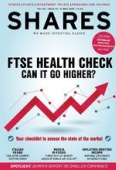Archived article
Please note that tax, investment, pension and ISA rules can change and the information and any views contained in this article may now be inaccurate.
FTSE 100 pension schemes move into surplus

Bring out the bunting! Just days after Prince Harry and American actress Meghan Markle, now the Duchess of Sussex, were married in Windsor, members of defined benefit (DB) schemes might also have been tempted to pop open the champagne in celebration.
Well maybe champagne is going a bit far, but certainly a drop of Buck’s Fizz. Because according to Lane Clarke & Peacock (LCP), a London-based pensions consultancy, FTSE 100 DB schemes ended 2017 in surplus – meaning they had more than enough assets on their aggregate balance sheets to pay off their estimated liabilities (that is the amount they expect to pay out in pensions).
Specifically, the firm reckons the UK’s biggest companies swung from a deficit of £31bn at the end of 2016 to a £4bn surplus at the end of last year.
It is the first time since 2007 – before the financial crash hit – that FTSE 100-sponsored schemes have recorded a year-end net surplus.
So why has this happened? And what does it mean for those who rely on DB schemes to pay out their pensions?
LCP cites three primary reasons for the improving of DB funding positions during 2017:
• Companies contributed a staggering £13bn towards the schemes over the course of the year – almost double the cost of the extra pension benefits members earned
• Many schemes were boosted by the stock market bull run, increasing the value of the assets on their balance sheet
• Some firms tweaked their life expectancy assumptions to reflect recent data suggesting improvements in life expectancy in the UK are slowing.
While this last point may seem at face value relatively insignificant, even tiny changes in the figures used to calculate life expectancy can wipe billions off the accounting value of a company’s DB liabilities.
WHAT SHOULD DB MEMBERS DO?
Just as scheme members shouldn’t be overly concerned by headlines saying DB deficits are ballooning, it’s also wise to take any claims that schemes are now swimming in pension cash with a pinch of salt.
As you can see from the graph, the funding position of schemes is extremely volatile and even the slightest shift in interest rates – or any other assumption for that matter - could add or remove tens of billions from the reported figure.
Rather than assessing aggregate figures, you should focus on the deficit (or surplus) of the scheme you are in and assess the strength of the employer responsible for paying pensions.
Even if you are worried about this, in most cases you would be well advised to stay where you are because, even if the worst does happen and the scheme sponsor fails, the Pension Protection Fund (PPF) exists as a valuable lifeboat for members.
You can read more about the protection provided by the PPF and DB transfers in general here.
Tom Selby,
senior analyst, AJ Bell
Important information:
These articles are provided by Shares magazine which is published by AJ Bell Media, a part of AJ Bell. Shares is not written by AJ Bell.
Shares is provided for your general information and use and is not a personal recommendation to invest. It is not intended to be relied upon by you in making or not making any investment decisions. The investments referred to in these articles will not be suitable for all investors. If in doubt please seek appropriate independent financial advice.
Investors acting on the information in these articles do so at their own risk and AJ Bell Media and its staff do not accept liability for losses suffered by investors as a result of their investment decisions.

 magazine
magazine









